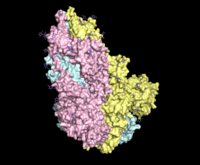Glycan-protein interactions

When you eat food, your body has to break it down into smaller pieces to use for energy and making other things your body needs. Imagine your food is a puzzle, and your body has to take it apart and put it back together to make it useful.
One of the important pieces in your food puzzle are sugars, which are called glycans. Glycans are like little flags or stickers on the surface of cells in your body. They help your cells communicate with each other and tell them if they should stick together or move apart.
Proteins are another piece of the puzzle. They are like the workers in your body who build and take apart things as needed. Proteins have different shapes and sizes, and they can do different jobs.
Sometimes, the little flags on the cells (glycans) will stick to the workers (proteins) in a specific way, like a lock and key. This is called a glycan-protein interaction. These interactions can help cells stick together or move apart, signal for help when the body is injured or infected, and even help direct the growth and development of cells in your body.
Scientists study glycan-protein interactions to learn more about how our bodies work and to find ways to help when things go wrong, like in diseases such as cancer, Alzheimer's, and inflammatory disorders. By understanding how these pieces fit together, they hope to create new medicines and treatments that can help people feel better and be healthier.
One of the important pieces in your food puzzle are sugars, which are called glycans. Glycans are like little flags or stickers on the surface of cells in your body. They help your cells communicate with each other and tell them if they should stick together or move apart.
Proteins are another piece of the puzzle. They are like the workers in your body who build and take apart things as needed. Proteins have different shapes and sizes, and they can do different jobs.
Sometimes, the little flags on the cells (glycans) will stick to the workers (proteins) in a specific way, like a lock and key. This is called a glycan-protein interaction. These interactions can help cells stick together or move apart, signal for help when the body is injured or infected, and even help direct the growth and development of cells in your body.
Scientists study glycan-protein interactions to learn more about how our bodies work and to find ways to help when things go wrong, like in diseases such as cancer, Alzheimer's, and inflammatory disorders. By understanding how these pieces fit together, they hope to create new medicines and treatments that can help people feel better and be healthier.
Related topics others have asked about:
